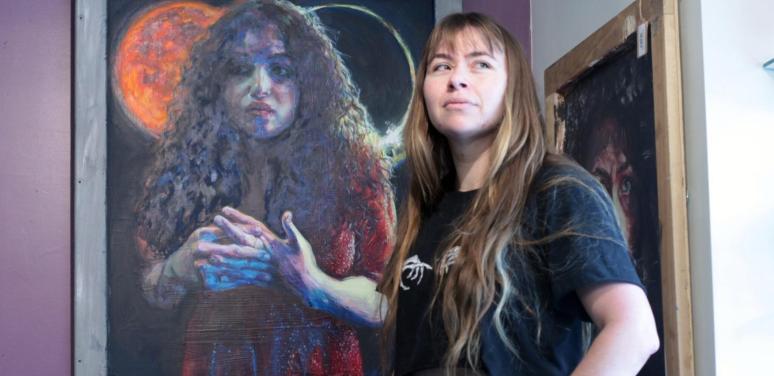The secret ‘shame’ of medical debt nearly crushed her. Then this Kansas artist fought back.

A Rural Crisis: Medical Debt in America's Heartland
By Max McCoy July 2024 Kansas Reflector
Whether it is literature or painting or any other creative endeavor, art “takes the ache away,” in the words of poet Robert Lowell. But it can also bring social change by exposing truths that most of us know, deep in the unquiet places of our hearts, but rarely speak of.
Such is the case of Emeline Fuller, a 37-year-old artist who speaks calmly about the pain that drove her, in the vernacular of the young, to unalive herself. The attempt was unsuccessful, she is now thankful, but it resulted in a hospital stay that she says deepened the secret loathing that edged her toward self-annihilation.
That secret shame, Fuller says, was medical debt.
Last summer, she channeled her suffering into a painting that depicted her severed head on a platter, like the Caravaggio of John the Baptist, over her bound and partially nude body. A dark, hooded figure with an axe stands behind, a butler or perhaps a waiter. In the blood from her wounds are written the names of three medical providers, including the local hospital, that had turned her accounts over to collection. The work is titled, “In Emporia, Medical Debt Collections are Served with a Garnish.”
She exhibited the work in a local gallery and posted it online.
She said on social media that she hoped the painting would start a local conversation about medical debt collection. It did, and soon people began sharing their stories with her — stories that differed in detail, but which were full of sadness and pain.
“I have been collecting people’s experiences with these facilities and practices,” she said in one post, “and hearing over and over again stories of people stopping treatment due to this, being garnished … and experiencing financial instability, shame and despair.”
The Suicide and Crisis Lifeline is a hotline for individuals in crisis or for those looking to help someone else. To speak with a certified listener, call 988.
A spokesman for the local hospital, Newman Regional Health, a county nonprofit, said he believed Fuller had been treated as fairly as the collection process allowed. He also said patients are given ample opportunity to apply for charity care.
“There was just such an immense amount of shame around that (debt),” Fuller told me recently, sitting in a coffee shop in downtown Emporia, her voice threatening to crack.
She was otherwise composed, her laptop open to remind her of dates and figures, and her sense of humor — or perhaps irony — was evident in her shirt, which had skeletal hands nearly touching fingers as in Michelangelo’s “Creation of Adam.”
“People want to pay their bills, and I’m no exception,” Fuller said. “I want to fulfil my obligations, but I just couldn’t. I didn’t have the ability. When you call and talk to these (collection) people, they’re not pleasant. Being dragged into court is not a great experience.”
She described her life after having her wages garnisheed by court order from 2015 to about 2020 as “dehumanizing.” Unable to afford utility payments, she spent a winter in a house without heat or running water, but pipes — which still had residual water in them — burst in the walls.
Her journey into medical debt began in 2012, when she was treated for cat-scratch disease, a bacterial infection, and her balances grew as she received mental health care for bipolar disorder.
Fuller said she was sick, in body and mind, for years, and she often avoided seeking treatment for fear of worsening the medical debt problem.
Fuller originally owed about $24,000. She believes she has paid about $18,000 toward that, but with interest and other fees the total is now $47,000, nearly twice the original amount.
Although Fuller felt alone in her shame, statistics from the Consumer Financial Protection Agency show that medical debt collections affect one in five Americans. Nationwide, such outstanding medical debt amounts to $88 billion, or about two-and-a-half times the annual budget of NASA.
Other organizations say the agency’s figures are low, and that the actual amount of all medical debt is closer to $220 billion. The Kaiser Family Foundation, an independent nonprofit dedicated to health policy research, says adults in rural areas are likely to carry more debt. In Kansas, according to KFF, about one in 10 adults have medical debt in a given year, slightly higher than the national average.
It’s difficult to determine medical debt collections at the state level because only nine states gather those kind of data. In states that do track such cases, as many as half of all civil filings involve debt collection, a trend unabated by the pandemic.
Kansas doesn’t keep statistics on medical debt collections, according to Lisa Taylor, public information director for the Kansas Supreme Court and Office of Judicial Administration. The state does keep data on adoptions, children in need of care, divorces, protection orders, property disputes and contract disputes — amounting to more than 110,000 civil cases in fiscal year 2022. Medical debt collection data isn’t gathered, Taylor said, because it’s not one of the categories required in the national reporting system the state uses. But just looking at the dockets of many of the district courts in Kansas, it’s apparent that medical debt collection represents a substantial fraction of cases, and sometimes the majority.
In September 2023, according to recent reporting by the Wall Street Journal, 95% of cases heard in one magistrate judge’s courtroom at Pratt, Kansas, were medical debt collections.
“In some rural areas, there’s hospitals that are obviously struggling financially, they’re trying to collect every coin, every dollar they can,” Matthew Keenan, the executive director of Kansas Legal Services, told me.
The organization provides free legal aid for poor Kansans seeking help with housing, debt, and other civil matters.
The arc of the medical debt crisis in Kansas, Keenan said, is probably best represented by two national news stories. The first, by ProPublica in 2019, was about the medical debt crisis in Coffeyville, and it described the situation as a “government-sanctioned shakedown of the uninsured and underinsured” where those who failed to show up for court were jailed. The second was the May 26 Wall Street Journal story, which examined Pratt Regional Medical Center as an example of a rural hospital aggressively pursuing collections from a population that tended to be older and underinsured. Kansas is one of only 10 states that hasn’t expanded Medicaid, which has increased the financial burden on patients and hospitals alike.
Keenan said we’re likely past the point now of throwing anybody in jail for failing to show up for a collection hearing, but that the state is still experiencing areas where medical debt is at crisis levels.
“You know, (the University of Kansas Health System) is a charitable hospital but they don’t sue their patients,” Keenan said. “By and large Stormont Vail (a Topeka hospital) doesn’t sue its patients. But you can find in Kansas charitable hospitals that are not very charitable. I mean in Liberal, you’re almost as likely to be sued as you are to be cured.”
The local hospital in Liberal, Keenan said, has sued 3,012 people in a county with a population of 22,000. That’s more than 13% of the community.
Federal law requires charitable hospitals — nonprofits that provide care for the poor and uninsured — to publish their financial assistance policies, which include eligibility criteria and methodology for charges, or risk losing tax breaks.
“They must provide a concise, clear and understandable plain language summary of their financial assistance policy,” Keenan said. “So the question is, what does that mean? How do they publicize it? And there is some room (in the law) that allows hospitals to interpret it in their own way.”
Newman Regional, the hospital included in Fuller’s painting of medical debt, bases its charity care on federal poverty guidelines.
A family of four, for example, might qualify for free or reduced care with a total income of less than $31,200.
Steven Bazan, Newman’s director of strategy and development, said patients are given ample notice of payment plan options. Billing statements have a number to call to set up a payment plan, he said, and multiple letters are sent out before an account is turned over to collection. He said he did not know how many accounts were currently in collection, or what percentage or dollar amount the agency charges the hospital. But last year, he said, the hospital wrote off $7.9 million in uncollected debt.
“We have our care coordination department,” Bazan said. “We have financial advisers that can answer questions regarding billing and address anything that might be inaccurate. We also have community care workers who are bilingual and help patients complete charity care applications. Patients are made aware of the availability of charity care when they check in.”
Bazan said he would not discuss Fuller’s complaints about the hospital for fear of violating patient privacy. But, he said, he would ask anyone with a billing problem to contact the hospital.
“I would first ask, have they engaged in a process for us to help? If not, then come and do that,” he said. “You know, many times it’s a result of nonengagement in our charity options that bring people to that place.”
Fuller, however, said she had many “engagements” with the hospital that ended with her being sued, her wages garnisheed, and money taken from her checking account. She has waged a one-woman online campaign to discourage others from seeking care at Newman. She also became incensed when she discovered, in an independent audit of the hospital, that in 2022 the company paid $284,652 to a company owned by a board member for patient account collection services.
Keenan, the director of Kansas Legal Services, said such an arrangement raises a red flag.
“I think anyone would want to bring further scrutiny to that situation,” he said. “Perhaps it’s completely above board, but it would merit further investigation for sure.”
Bazan said while the audit report was accurate, the member in question — Richard Duncan — is no longer on the board because his term expired. The hospital continues to use the collection agency, CBCS, as it has for the past 25 or so years. Bazan said the decision to use the collection agency was an administrative decision, not a board decision, and that Duncan had properly disclosed his conflict of interest. Duncan’s wife, Monica, who also has a substantial interest in CBCS, is a member of Newman’s Quality and Compliance Committee, a volunteer position.
“So you had a board member who personally profited off sending as many people to collections as possible,” Fuller said during my meeting with her. “I’m really furious.”
It’s easy to see why Fuller has been so angry for so long.
Even for those in relatively good health, a bad turn of luck — an accident, cancer, the loss of a job with benefits — can mean financial catastrophe. Discovering that a hospital board member owned the collection agency that was hounding her must have been, for Fuller, like somebody shoving salt in an open wound.
The word that Fuller uses often in describing her ordeal with medial debt is “predatory.” She discovered this characterization during her research into a 2021 Johns Hopkins study into medical debt, and as reported by ProPublica.
Fuller says her activism — and her recovery — started when a new psychiatrist put her on a different medication, one that worked. She began thinking about her life, reviewing how she had gotten to the place where she was living without heat or water, and started asking others for their experiences in an attempt to understand what had happened to her.
She graduated from Emporia State University in 2021 and is now a graduate student in art at the University of Kansas. As a KU grad student, she said, she had access to health insurance for the first time as an adult.
“It allowed me to stabilize my life,” Fuller said. “And then finally I was able to talk to other people (about the debt). I was no longer under this dense cloud of shame. And the more I talked to people, the more I realized how normal it was.”
So what is Fuller’s advice to others with medical debt?
“I’ve never found anything that really worked,” she said. “You have to be at the poverty level to get any help.”
Keenan said the best way to fight medical debt is to arm yourself with information.
“The magic words are to ask to see the financial assistance policy,” he said. “And number two, ask to speak to one of the financial counselors at the hospital to see what their eligibility is.”
But the sure way to get medical debt collectors to back down, he said, is to be represented by an attorney who can safeguard your rights.
“It’s a shame many former patients don’t have the benefit of an attorney who can make these arguments,” Keenan said. “The charitable hospitals pay no taxes. They get generous deductions, and in return for that they sue people in their own neighborhoods and towns, for medical care, that should be part of their charitable mission.”
Fuller told me recently that Newman had stayed collections on the remainder of her debt to give her time to apply for the hospital’s financial assistance program. She said she had agreed to pay $50 per month in the meantime and provide three years of tax returns.
“I have a reprieve from the garnishment,” she said, “and that’s amazing.”
That’s good news for Fuller, but I worry about the many others facing crushing medical debt. Her graphic painting, based on her long experience with collections, provided a commentary about medical care that should shame us as a society.
Our health care system is driven, on the policy level, by a medical insurance complex that places revenue over healing and compounds the suffering of those in medical crises. Most of the medical caregivers I know are dedicated professionals who give their best to their patients. But that compassion is wasted if patients, like Fuller, are afraid to seek care for fear of accumulating more debt.
Part of the answer, at least in Kansas, is expanding Medicaid, a move that has popular support but which keeps getting killed in the Legislature. That would take some of the pressure off both patients and hospitals. Beyond that, as a nation we must provide relief for the millions of individuals whose lives are hindered — or worse — by the burden of medical debt.
It is an everyday horror from which most of us choose to look away.
Max McCoy is an award-winning author and journalist. Through its opinion section, the Kansas Reflector works to amplify the voices of people who are affected by public policies or excluded from public debate. Find information, including how to submit your own commentary, here.



